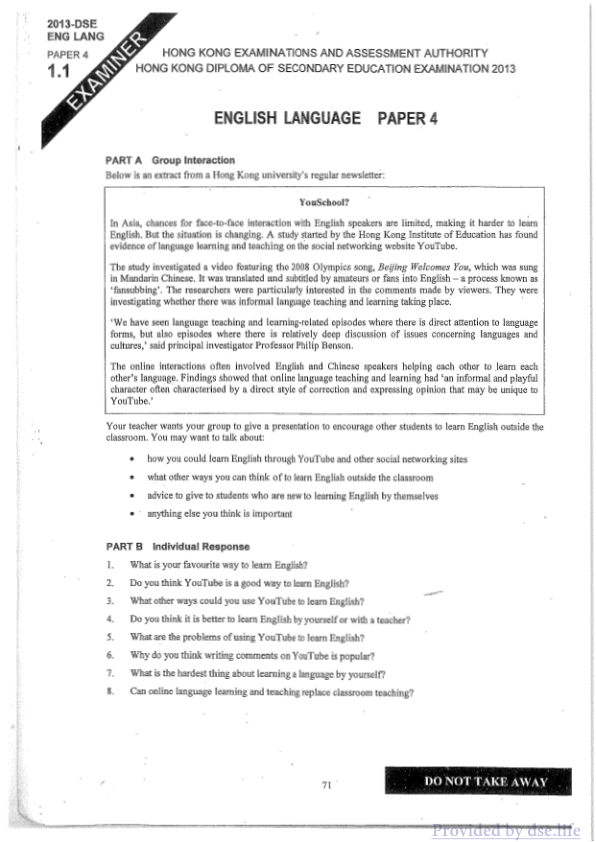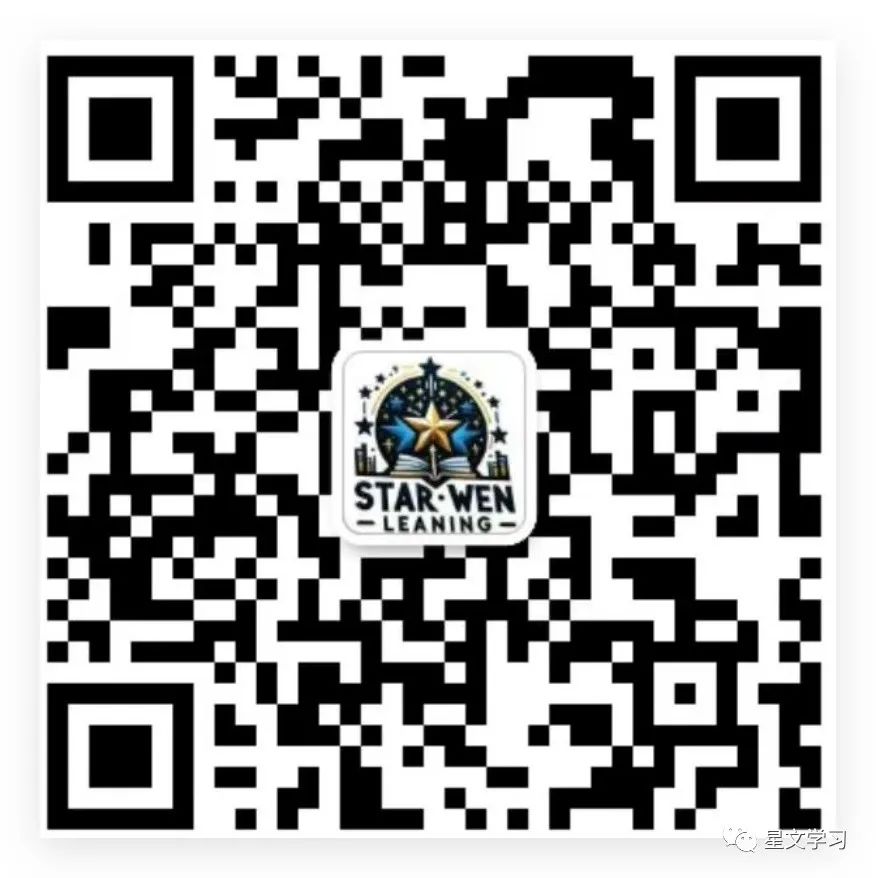2013 DSE 英国语文-English 真题 答案 详解
2013-05-03 dse dse 英国语文-English
| 序号 | 文件列表 | 说明 | ||
|---|---|---|---|---|
| 1 | 2013-英国语文-English-answer.pdf | 6 页 | 637.32KB | 答案 |
| 2 | 2013-英国语文-English-paper1.pdf | 21 页 | 3.14MB | 真题 Paper 1 |
| 3 | 2013-英国语文-English-paper2.pdf | 8 页 | 3.92MB | 真题 Paper 2 |
| 4 | 2013-英国语文-English-paper3.pdf | 37 页 | 18.75MB | 真题 Paper 3 |
| 5 | 2013-英国语文-English-paper4.pdf | 60 页 | 8.72MB | 真题 Paper 4 |
答案
DSE 2013 MARKING SCHEMES
This document was prepared for makers' reference. It should not be regarded as a set of model answers. Candidates and teachers who were not involved in the marking process are advised to interpret its content with care.
Paper 1 (Reading)
Part A (compulsory section) 1. B [57] 2. it is (an) emperor's tomb // (the) burial complex of China's first emperor // the place where China's first emperor was buried // a place where they found the terra-cotta warriors // archaeological/excavation site // it is a 2,200 year-old mystery [17] 3. fragments/pieces of the terra-cotta army // the broken terra-cotta warriors // putting together pieces of the terra-cotta warriors [9] 4. transform(ing)/rebuilding/repairing a heap of clay fragments into a (full-size) warrior // reassemble(ing) an army of (terra-cotta) warriors // piecing together terra-cotta warriors [70] 5. digging a well (for their orchard) [47] 6. Statement i) The three women in the persimmon orchard are the same age. ii) The burial complex remains a mystery. iii) It usually takes a few hours to piece together a complete terra-cotta warrior. iv)* Yang Rongrong has been piecing together terra-cotta warriors for 39 years. 7. C [57] 8. monochrome [37] 9. he achieved/accomplished/did a lot during his reign // made great contribution // did a lot to develop China // develop the country in many aspects [11] 10. B [77] 11. warriors' colors disintegrated into the (dry Xian) air // the colours were exposed to (the dry Xian) air [83] 12. how quickly/fast the paint/colour begins to cur/flake off/disintegrate // vibrant pieces of history are lost in a short period of time [38] 13. A [45] 14. Conservation Office in Germany and Chinese researchers // Chinese researchers and German experts [40] 15. to keep in the (protective) moisture // to keep it/artifact/wet/moist // to protect it/artifact from the (dry) air // to save/preserve/keep/protect the colour [74] 16. Step Order (1-4) Send the artifact to an on-site laboratory. 4 Spray the colour with a solution. 2 Wrap the artifact in plastic. 3 Unearth the artifact. 1 [73]
- (i) clay quivers [24] (ii) chariot [27] (iii) shield [24] (iv) military drum [29]
- D [49]
- so much color and artistry has been imprinted on the soil // the ancient paint(alas) adheres to dirt more readily than to lacquer [28]
- (i) Rong/chemists/researchers/scientists/experts/preservation/preservationists [47] (ii) create/find/develop/discover/invent [62] (iii) (re)applying [63] (iv) binding agent [63] 21. Statement i) Only a small portion of the tomb has been excavated. ii) The speed of discovering new artifacts is slowing down. iii) In 2011, the museum completed the excavation of the central burial mound. T F NG [64] [68] [40]
- D [47]
- C [53] 24. Paragraphs (A-F) 2-3 B [70] 4-5 A [65] 6-7 C [52] 8-10 D [55] 11 F [60] 12-13 E [48]
- C [70] Part B1
- since ancient times // during the Qin Dynasty [82]
- B [55]
- turbulent [43]
- they have been exposed to its sound since childhood [85]
- Zou believes Westerners like the guzheng because it sounds_exotic_and_relaxing_ [59]
- i) social activity [77] ii) sense of accomplishment [37] iii) artistic expression [41] 32. Statement i) Zou teaches the guzheng. ii) The guzheng is Zou's favourite instrument. iii) No one else in Zou's family can play the guzheng. iv) Famous people have attended Zou's performances. T F NG [83] [67] [76] [51] 131 132 Provided by dse.life
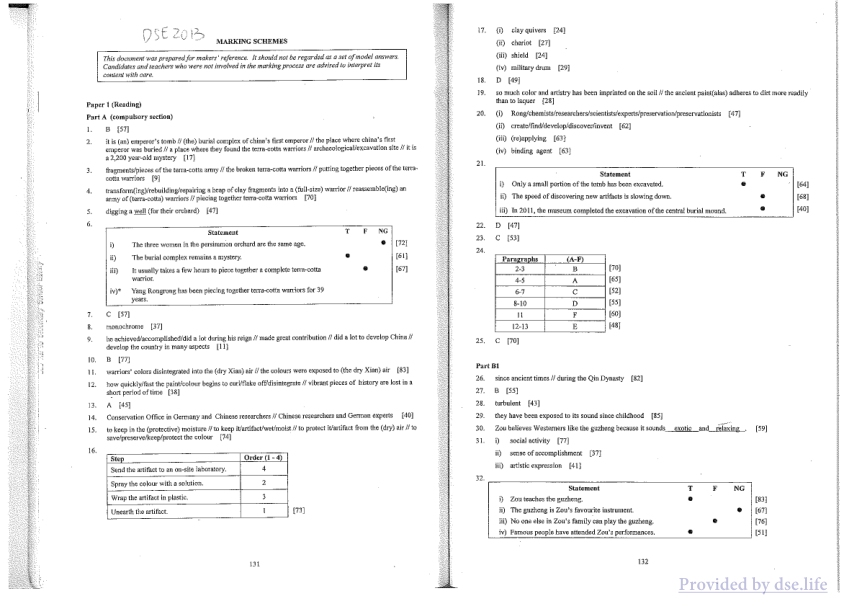
真题 Paper 1
2013-DSE ENG LANG PAPER 1 PART A
HONG KONG EXAMINATIONS AND ASSESSMENT AUTHORITY HONG KONG DIPLOMA OF SECONDARY EDUCATION EXAMINATION 2013
A COMPULSORY
ENGLISH LANGUAGE PAPER 1 PART A Reading Passages 8:30 am – 10:00 am (1½ hours) (for both Parts A and B)
GENERAL INSTRUCTIONS
(1) There are two parts (A and B) in this paper. All candidates should attempt Part A. In Part B, you should attempt either Part B1 (easier section) OR Part B2 (more difficult section). Candidates attempting Parts A and B2 will be able to attain the full range of levels, while Level 4 will be the highest level attainable for candidates attempting Parts A and B1.
(2) After the announcement of the start of the examination, you should first write your Candidate Number and stick barcode labels in the spaces provided on the appropriate pages of the Part A Question-Answer Book and the Part B Question-Answer Book which you are going to attempt.
(3) Write your answers in the spaces provided in the Question-Answer Books. Answers written in the margins will not be marked.
(4) For multiple-choice questions, you are advised to blacken the appropriate circle with a pencil so that wrong marks can be completely erased with a clean rubber. Mark only ONE answer to each question. Two or more answers will score NO MARKS.
(5) Supplementary answer sheets will be supplied on request. Write your Candidate Number, mark the question number box and stick a barcode label on each sheet and fasten them with string INSIDE the Question-Answer Book.
(6) No extra time will be given to candidates for sticking on barcode labels or filling in the question number boxes after the 'Time is up' announcement.
(7) The two Question-Answer Books you have attempted (one for Part A and one for Part B) will be collected together at the end of the examination. Fasten the two Question-Answer Books together with the green tag provided.
(8) The unused Question-Answer Book for Part B will be collected separately at the end of the examination. This will not be marked. Do not write any answers in it.
INSTRUCTIONS FOR PART A
(1) The Question-Answer Book for Part A is inserted in this Reading Passages booklet.
(2) Attempt ALL questions in Part A. Each question carries ONE mark unless otherwise stated.
Not to be taken away before the end of the examination session
2013-DSE-ENG LANG I-A-RP-1 9 Provided by dse.life
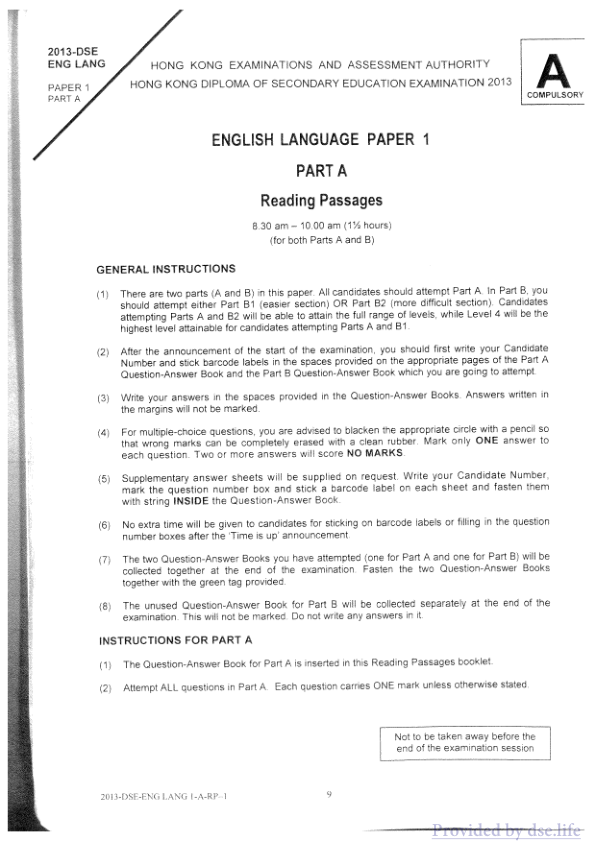
真题 Paper 2
2013-DSE ENGLANG PAPER 2
HONG KONG EXAMINATIONS AND ASSESSMENT AUTHORITY HONG KONG DIPLOMA OF SECONDARY EDUCATION EXAMINATION 2013
ENGLISH LANGUAGE PAPER 2 Question-Answer Book 11:00 am - 1:00 pm (2 hours) (for both Parts A and B)
INSTRUCTIONS There are two parts (A and B) in this paper. Candidates should attempt Part A and ONE question from Part B. After the announcement of the start of the examination, you should first write your Candidate Number in the space provided on Page 1 and stick barcode labels in the spaces provided on Pages 1 and 3.
For Part B, you should put an 'X' in the corresponding question number box on Page 6 to indicate the question you are going to attempt.
Write your answers in the space provided in this Question-Answer Book. Answers written in the margins will not be marked.
Do not use your real name in answering any of the questions. If names are provided in the question, you must use those names. If no name is provided and you still wish to use a name to identify yourself, then use 'Chris Wong'. If you need to use names for other characters in the composition not specified by the question, you may use names such as Mary, Peter, Mr Smith, Ms Young, etc. You may lose marks if you do not follow these instructions.
Rough work should be done on the rough-work sheets which will be collected separately. These will not be marked.
Supplementary answer sheets will be supplied on request. Write your Candidate Number, mark the question number box and stick a barcode label on each sheet and fasten them with string INSIDE this book.
No extra time will be given to candidates for sticking on the barcode labels or filling in the question number boxes after the 'Time is up' announcement.
Please stick the barcode label here.
Candidate Number
2013-DSE-ENG LANG 2-1 26 AO20E002
Provided by dselife
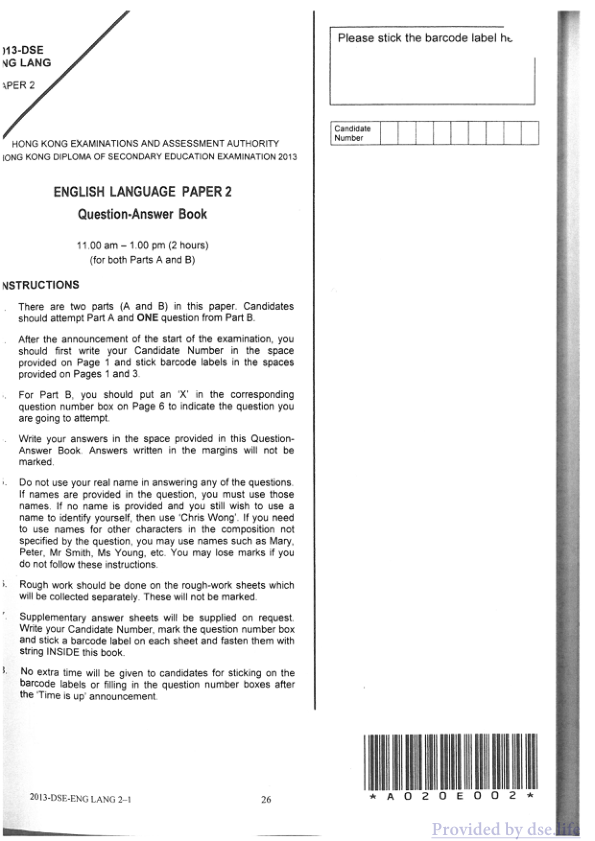
真题 Paper 3
2013-DSE ENG LANG PAPER 3 PART B1
HONG KONG EXAMINATIONS AND ASSESSMENT AUTHORITY HONG KONG DIPLOMA OF SECONDARY EDUCATION EXAMINATION 2013
ENGLISH LANGUAGE PAPER 3 PART B1 DATA FILE
GENERAL INSTRUCTIONS (1) Refer to the General Instructions on Page 1 of the Question-Answer Book for Part A.
INSTRUCTIONS FOR PART B1 (1) The Question-Answer Book for Part B1 is inserted into this Data File. (2) For Part B, attempt EITHER those tasks in Part B1 (Tasks 5 - 7) OR those in Part B2 (Tasks 8 - 10). (3) You are advised to use a pen for Part B. (4) The Data Files will NOT be collected at the end of the examination. Do NOT write your answers in the Data Files. (5) Hand in only ONE Question-Answer Book for Part B, either B1 or B2, and tie it with the Question-Answer Book for Part A.
Not to be taken away before the end of the examination session
2013-DSE-ENG LANG 3-B1-DF-1 45 Provided by dse.life

真题 Paper 4
2013-DSE ENG LANG PAPER 4 EXAMINER 1.1 HONG KONG EXAMINATIONS AND ASSESSMENT AUTHORITY HONG KONG DIPLOMA OF SECONDARY EDUCATION EXAMINATION 2013 ENGLISH LANGUAGE PAPER 4 PART A Group Interaction Below is an extract from a Hong Kong university's regular newsletter: YouSchool? In Asia, chances for face-to-face interaction with English speakers are limited, making it harder to learn English. But the situation is changing. A study started by the Hong Kong Institute of Education has found evidence of language learning and teaching on the social networking website YouTube. The study investigated a video featuring the 2008 Olympics song, Beijing Welcomes You, which was sung in Mandarin Chinese. It was translated and subtitled by amateurs or fans into English - a process known as 'fansubbing'. The researchers were particularly interested in the comments made by viewers. They were investigating whether there was informal language teaching and learning taking place. ‘We have seen language teaching and learning-related episodes where there is direct attention to language forms, but also episodes where there is relatively deep discussion of issues concerning languages and cultures,' said principal investigator Professor Philip Benson. The online interactions often involved English and Chinese speakers helping each other to learn each other’s language. Findings showed that online language teaching and learning had ‘an informal and playful character often characterised by a direct style of correction and expressing opinion that may be unique to YouTube.' Your teacher wants your group to give a presentation to encourage other students to learn English outside the classroom. You may want to talk about: how you could learn English through YouTube and other social networking sites what other ways you can think of to learn English outside the classroom advice to give to students who are new to learning English by themselves anything else you think is important PART B Individual Response What is your favourite way to learn English? Do you think YouTube is a good way to learn English? What other ways could you use YouTube to learn English? Do you think it is better to learn English by yourself or with a teacher? What are the problems of using YouTube to learn English? Why do you think writing comments on YouTube is popular? What is the hardest thing about learning a language by yourself? Can online language learning and teaching replace classroom teaching? 71 DO NOT TAKE AWAY Provided by dse.fle
